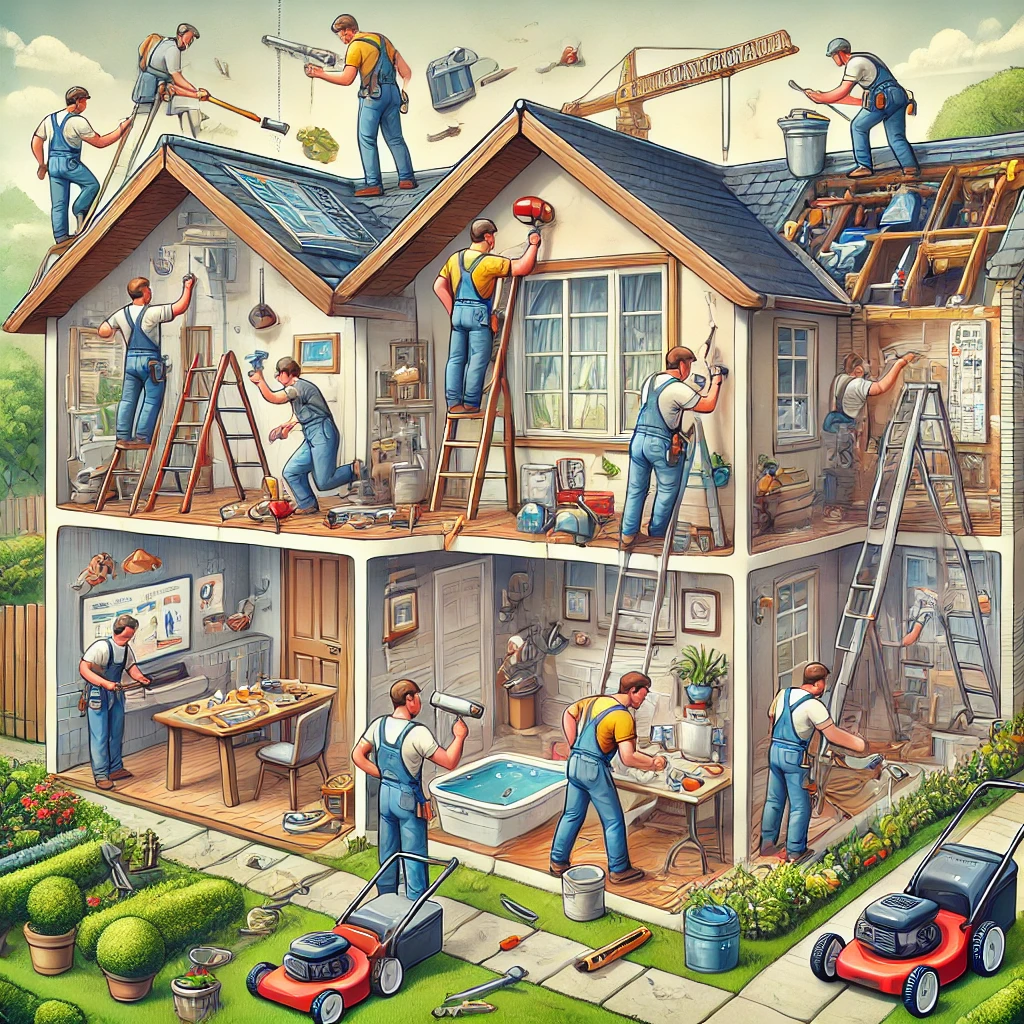Table of Contents
Introduction: The Importance of DIY Home Maintenance
Home maintenance is a crucial aspect of homeownership that ensures the longevity and functionality of a residence. While professional services are sometimes necessary, engaging in DIY home maintenance can offer significant benefits. Firstly, it provides substantial cost savings. Many repairs and upkeep tasks that might otherwise require professional intervention can be managed with basic household tools and a bit of know-how, reducing overall household expenses.
The convenience of addressing issues promptly is another advantage. Homeowners who are skilled in DIY home maintenance can tackle problems as soon as they arise, preventing minor issues from escalating into major, costly repairs. This proactive approach not only preserves the structural integrity of the home but also fosters a more pleasant living environment.

Additionally, there is an intangible yet profound sense of accomplishment that comes with successfully completing home maintenance tasks. Engaging in these activities empowers homeowners, offering a deep sense of satisfaction and increased confidence in their abilities. The empowerment derived from mastering home maintenance can extend to other areas of life, promoting a proactive and capable mindset.
This blog post will explore the top 10 DIY home maintenance projects that every homeowner should know. From cleaning gutters and fixing leaky faucets to maintaining HVAC systems and dealing with minor electrical issues, these projects are not only manageable but also essential in keeping a home running smoothly.
1. Fixing a Leaky Faucet
A leaky faucet is a prevalent issue in home maintenance that can significantly waste water and increase utility bills if not addressed promptly. Common causes of a leaky faucet include worn-out washers, corroded valve seats, loose O-rings, or broken seals. Identifying the root of the problem is essential to effectively resolve the leak.
To fix a leaky faucet, you will need several tools, including a wrench, screwdriver, and replacement parts. Here is a detailed step-by-step guide to assist you:
Step 1: Turn off the water supply to the faucet. This can typically be done by turning off the valves located beneath the sink. If there are no shut-off valves, turn off the main water supply for the house.
Step 2: Plug the sink drain to prevent any small parts from falling down the drain. This precaution can save time and effort during the repair process.
Step 3: Using a wrench or screwdriver, remove the faucet handle. This might require unscrewing a decorative cap or using an Allen wrench to access the set screw.
Step 4: Carefully remove the cartridge, compression, or ball faucet assembly. Inspect the components for any obvious wear or damage. Worn-out washers and seals are common culprits behind leaks.
Step 5: Replace any damaged parts. For example, if the washer is worn out, replace it with a new one of the same size and type. Lubricate the new parts if necessary before reassembly.
Step 6: Reassemble the faucet, ensuring each part is securely in place. Tighten all components using the corresponding tools.
Step 7: Turn the water supply back on and test the faucet. Ensure there are no drips or leaks when the faucet is both on and off. If the leak persists, additional troubleshooting may be required, such as checking for internal corrosion or incorrectly installed parts.
Addressing a leaky faucet as part of your home maintenance routine can save water and prevent further damage. Always ensure you use compatible replacement parts and adhere to manufacturer guidelines to achieve a lasting, leak-free repair.
2. Unclogging Drains
Clogged drains are a prevalent issue in many households, typically caused by an amalgamation of hair, grease, soap scum, and debris. These blockages can lead to slow drainage, unpleasant odors, and, if neglected, more severe plumbing problems. To mitigate these issues and ensure efficient drainage, several DIY techniques, tools, and materials can be employed to maintain your home’s plumbing system.
Essential tools and materials for unclogging drains include a plunger, a drain snake, and common household items such as baking soda and vinegar. These tools cater to different types of clogs and homeowner preferences for chemical versus natural remedies. Chemical solutions, like commercial drain cleaners, provide a powerful method to dissolve stubborn clogs but must be used cautiously to avoid damaging pipes. Natural remedies, often preferred by environmentally-conscious homeowners, include a combination of baking soda, vinegar, and boiling water. This method is both effective and gentle on plumbing systems.
For mechanical techniques, begin with a plunger, which is suitable for minor clogs in sinks, toilets, and bathtubs. Ensure the plunger forms a tight seal over the drain opening, then apply forceful, consistent plunging motions until the clog is dislodged. If the plunger proves ineffective, a drain snake—also known as a plumber’s auger—can be more effective. Insert the snake into the drain and rotate it to break up or entangle the clog, then pull out the blockage.
In some cases, despite the best DIY efforts, a clog might prove too persistent or severe. Situations involving frequent clogs, particularly in multiple drains, or a complete blockage that doesn’t respond to DIY methods indicate a more profound issue within the plumbing system. At this juncture, calling a professional plumber becomes necessary. They possess the expertise and advanced equipment required to inspect, diagnose, and resolve the underlying problem, ensuring the home maintenance task is comprehensively addressed.
3. Caulking and Sealing Windows
Effective home maintenance encompasses a range of tasks, among which caulking and sealing windows emerge as pivotal for sustaining energy efficiency and keeping household utility costs in check. Properly sealed windows prevent drafts and leaks, ensuring that your home remains comfortable throughout the year. This project, thereby, not only contributes to energy conservation but also enhances the longevity of your windows and adjacent structures.
To embark on this maintenance task, you’ll need several essential materials: quality caulk, a caulking gun, a utility knife or scraper, and a clean, damp cloth. A step-by-step approach, as detailed below, can streamline the process and ensure professional-grade results:
Firstly, preparation is key. Begin by thoroughly inspecting the current caulk around your windows. Using a utility knife or scraper, carefully remove any old, cracked, or peeling caulk. This step is crucial, as any residue can hinder the adhesion of new caulk. After removing the old caulk, clean the area with a damp cloth, ensuring all dust and debris are eliminated.
Once the surfaces are prepped, load your caulking gun with a tube of high-quality caulk. Silicone or acrylic caulk are excellent choices due to their durability and flexibility. Cut the tip of the caulk tube at a 45-degree angle to allow for better control during application. Begin applying the caulk along the seams of the window frame in a continuous, smooth motion. It’s important to maintain steady pressure on the caulking gun to produce an even bead of caulk.
To achieve a clean, professional finish, dampen your finger or a caulk-smoothing tool and gently run it along the bead of caulk, pressing it into the seam and smoothing out any excess. This not only improves the appearance but also ensures a solid seal. Finally, allow the caulk to cure completely, as per the manufacturer’s instructions, before exposing it to moisture or heavy use.
By adhering to these guidelines, homeowners can sustain the energy-efficiency of their homes, mitigate potential water damage, and extend the life of their windows through effective caulking and sealing practices.
4. Replacing Air Filters
Regularly replacing air filters is paramount for sustaining superior indoor air quality and ensuring the optimal performance of your HVAC system. An efficient air filtration system traps dust, pollen, pet dander, and other airborne particles, reducing the risk of respiratory issues and enhancing overall home comfort. Neglecting this aspect of home maintenance can lead to a clogged filter, forcing your HVAC system to work harder, thereby increasing energy consumption and potentially causing premature system failures.
There are several types of air filters available, each serving different purposes. The most common types include fiberglass filters, pleated filters, electrostatic filters, and HEPA filters. Fiberglass filters are cost-effective but offer basic filtration, needing replacement every 30 days. Pleated filters capture more particles and typically last up to 90 days. Electrostatic filters, which can be either washable or disposable, use self-charging fibers to attract particles. Washable ones should be cleaned every month, while disposable alternatives require replacement every three months. HEPA filters are highly efficient, removing up to 99.97% of airborne particles and usually need changing every six to twelve months.
Replacing air filters is straightforward. First, locate your filter’s housing, which is generally within your return air duct or near the air handler in the HVAC system. Turn off your HVAC system before beginning the replacement process. Open the filter housing cover and carefully remove the old filter. Note the size printed on the filter’s frame, ensuring you purchase the correct replacement. Align the new filter, ensuring that the airflow arrows on its frame point in the direction of the system’s airflow, usually towards the blower motor. Secure the housing cover back in place and turn the system back on.
When choosing the right air filter, consider your specific needs. For households with pets or allergy sufferers, opt for pleated or HEPA filters, which provide superior filtration. Those looking for budget-friendly options for general use may find fiberglass filters sufficient. Ensure to match the size and MERV rating to your HVAC system for optimum performance. Regular maintenance and appropriately selected filters not only promote better indoor air quality but also prolong the lifespan and efficiency of your HVAC system.
5. Touching Up Paint
Touching up paint is a fundamental aspect of home maintenance that plays a crucial role in preserving the aesthetic appeal of your home. Regular touch-ups help to mask minor imperfections such as scratches, nicks, and faded spots that can accumulate over time. This not only maintains the beauty of the living space but also protects the surfaces from potential long-term damage.
To begin with your paint touch-up project, you will need a set of essential supplies. These include a small can of paint that matches your wall color, good quality brushes, sandpaper, and cleaning materials. Having these items on hand ensures that you can address any paint imperfection as soon as it appears, thereby extending the life of your home’s decor.
The first step in the touch-up process involves cleaning the area that needs attention. Use a damp cloth to remove any dust, grease, or debris. This ensures that the paint adheres properly to the surface. Next, you’ll want to lightly sand the area to smooth out any rough edges or peeling paint. This step is crucial for creating a flawless finish.
Matching the paint color precisely is imperative for a seamless touch-up. If you can’t find the original paint can, take a sample to a paint store to get a custom match. Mix the paint thoroughly to ensure an even color and then apply it in thin layers using a high-quality brush. It’s better to apply several thin coats rather than one thick layer, as this promotes better blending.
Blending the touched-up area with the existing paint is an art. Feather the edges of your touch-up to avoid hard lines. You might also gently dab the edges with a slightly damp sponge to diffuse the new paint into the old. Allow each coat to dry completely before adding another, and patiently build up the layers until the surface looks consistent.
By following these steps meticulously, you can maintain the pristine look of your walls and enjoy a well-maintained home environment. Regular home maintenance, including mindful paint touch-ups, significantly contributes to the longevity and appeal of your living space.
6. Cleaning Gutters
Regular gutter cleaning is a pivotal aspect of home maintenance, crucial for preventing water damage and ensuring proper drainage. Accumulated debris, such as leaves, twigs, and dirt, can obstruct the flow of water, leading to water pooling and potential damage to your home’s foundation, roof, and walls. Regular maintenance of gutters helps avoid such complications and extends the lifespan of your property.
When preparing to clean your gutters, it is essential to use the appropriate safety equipment and tools. These include sturdy gloves to protect your hands from sharp objects and contaminants, a stable ladder that can reach your gutter height safely, and a gutter scoop to remove debris effectively. Additionally, you may need a garden hose to flush out finer residue and reveal any hidden clogs or blockages.
Begin the cleaning process by positioning the ladder securely on flat ground. Always ensure that someone is nearby to assist or spot you. Wearing your gloves, carefully scoop out the larger debris from the gutters using the gutter scoop, placing the waste into a bucket or onto a tarp below. Once you have removed the bulk of the blockages, use the garden hose to flush the gutters, starting at the end farthest from the downspout to push any remaining debris towards it. This approach helps in ensuring the downspout is clear and functioning properly.
While cleaning, inspect your gutters for signs of damage or wear. Look for any sagging sections or joints that may have come loose and check for rust, cracks, or holes. Small cracks can be sealed using a gutter sealant, while sagging sections may need to be reattached using appropriate hardware. If the damage is extensive, it might be more prudent to replace the affected sections of the gutter.
To maintain your gutters year-round, consider installing gutter guards to minimize the accumulation of debris. Regularly check and clean your gutters, particularly after stormy or windy weather, and ensure downspouts are directed away from your home’s foundation. By integrating these practical steps into your home maintenance routine, you can maintain efficient gutter function, saving you from costly repairs and preserving the structural integrity of your home.
7. Testing and Replacing Smoke Detectors
Ensuring that smoke detectors are functional is a vital aspect of home maintenance. Smoke detectors provide early warning signals in the event of a fire, giving occupants critical moments to evacuate safely. Regular testing and timely replacement of smoke detectors can significantly mitigate fire-related risks and enhance home safety.
Importance of Functional Smoke Detectors
Functional smoke detectors are indispensable in every household. They serve as the first line of defense against potential fire hazards, alerting residents to smoke presence, which may indicate an impending fire. Properly maintained smoke detectors reduce the likelihood of injuries and fatalities in fire emergencies, underscoring the importance of their upkeep as a key home maintenance task.
Testing Smoke Detectors
Testing smoke detectors should be integrated into your routine home maintenance schedule. To test a smoke detector, press and hold the test button until you hear a loud alarm sound. This sound, typically a high-pitched siren, should emit for several seconds. Conduct this test monthly to ensure the sound is audible and the detector is functioning effectively. If there is no sound or it is weak, it is time to replace the batteries or the detector itself.
Signs of Replacement
Smoke detectors exhibit clear signs when replacement is necessary. Frequent false alarms, an inability to produce the test alarm sound, or a unit older than ten years are all indicative of the need for a new smoke detector. Smoke detector units generally have a lifespan of about ten years, after which their sensors may degrade and become unreliable.
Replacing Batteries and Units
For battery-operated smoke detectors, replace the batteries at least once a year or when the low-battery warning chirps. To replace the entire unit, follow the manufacturer’s instructions, which typically involve detaching the old unit, connecting the wires to the new unit, and securing it in place. Hardwired smoke detectors might require professional assistance for safe installation.
Recommended Locations and Testing Frequency
Install smoke detectors on every level of your home, within each bedroom, and outside sleeping areas. They should be mounted on the ceiling or high on walls, avoiding placement near windows, doors, or ducts where drafts might interfere with their operation. Perform testing monthly and schedule battery replacements annually to uphold their functionality.
Incorporating these practices into your home maintenance routine ensures the consistent performance of your smoke detectors, fostering a safer living environment.
8. Maintaining Your Water Heater
Regular maintenance of your water heater is essential for its efficiency and longevity. Proper upkeep can prevent costly breakdowns and ensure your home maintains a consistent supply of hot water. Neglecting this critical home maintenance task may result in sediment buildup, decreased efficiency, or even premature equipment failure.
To get started, gather the necessary tools and materials: a garden hose, an adjustable wrench, and a bucket. These simple items will enable you to complete most basic water heater maintenance tasks efficiently.
First, check and adjust the temperature. For most households, setting the thermostat to 120 degrees Fahrenheit is sufficient. This prevents scalding and improves energy efficiency. Use the thermostat on the water heater to check the current temperature and adjust it as needed.

Next, drain the tank to remove sediment buildup. Begin by turning off the power supply to the water heater. For electric models, switch off the circuit breaker; for gas models, turn the gas valve to the “pilot” setting. Connect the garden hose to the drain valve located at the bottom of the tank. Place the other end of the hose in a bucket or direct it outside. Open the drain valve and allow the tank to empty completely. Once it’s drained, close the valve and remove the hose. Turn the water supply back on and refill the tank, then restore power.
Inspecting for leaks is another critical step. Examine the area around the water heater for any signs of moisture or pooling water. Pay close attention to the connections and fittings, using an adjustable wrench to tighten any loose parts if needed.
While regular home maintenance can often suffice, certain situations may require professional intervention. If you notice excessive rust, unusual noises, or persistent issues even after basic upkeep, it is advisable to contact a licensed technician. Recognizing when professional assistance is necessary ensures the safety and functionality of the water heating system in your home.





